The Complete Guide to Food Processing: Understanding What You Eat
Everything you need to know about food processing levels, the NOVA classification system, and how to make healthier choices for you and your family.
Table of Contents
Introduction: What Is Food Processing?
Simple Definition
Food processing is any deliberate change made to food before it reaches your plate. This incredibly broad definition encompasses everything from washing an apple to creating a packaged snack bar.
At its core, food processing involves transforming raw agricultural products into forms that are safe, convenient, nutritious, or appealing to consumers.

The food processing spectrum: from minimal interventions to complex industrial manufacturing
The spectrum ranges from minimal interventions—like freezing vegetables to preserve freshness—to complex industrial manufacturing that creates entirely new food products using multiple ingredients, additives, and sophisticated machinery. Understanding this spectrum is crucial because not all food processing is created equal.
Why It Matters for Your Health
The degree of food processing directly impacts the nutritional value, safety, and health effects of what you eat. This isn't just academic knowledge—it has real-world implications for your daily food choices and long-term health outcomes.
Research Shows:
- • Diets high in minimally processed foods → Lower disease risk
- • Diets heavy in ultra-processed foods → Higher disease risk
- • Processing affects satiety signals and nutrient absorption
By understanding food processing levels, you can make informed decisions that support your health goals without completely eliminating the convenience and safety benefits that some processing provides. The key is learning to distinguish between helpful processing and potentially harmful ultra-processing.
The 4 Types of Food Processing (NOVA System)
The NOVA system revolutionized how we think about food by shifting focus from individual nutrients to the degree of food processing. Developed by researchers at the University of São Paulo, this classification has become the international standard for understanding food processing's impact on health. To dive deeper into this crucial framework, explore our detailed guide onwhat is the NOVA classification system.
Why NOVA Matters: Unlike traditional nutrition labels that focus on calories and nutrients, NOVA considers how foods are made—which research shows is equally important for health outcomes.
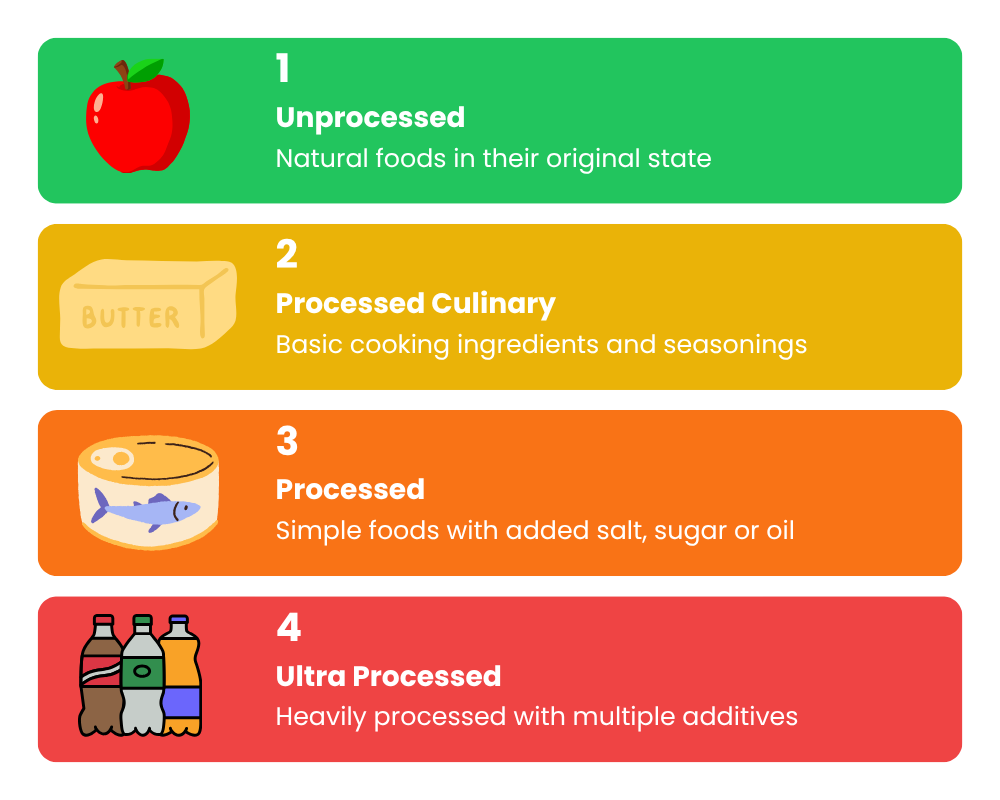
The NOVA classification system: Four distinct categories of food processing
Group 1: Unprocessed & Minimally Processed Foods
Minimal or unprocessed foods are as close to their natural state as possible. These foods have undergone little to no alteration from their original form, with processing limited to simple techniques that preserve the food's inherent nutritional profile.
What qualifies as minimal processing:
- • Washing, cleaning, and removing inedible parts
- • Simple cutting, slicing, or chopping
- • Freezing without additives
- • Drying or dehydrating without chemicals
- • Pasteurization for safety
- • Simple fermentation (like plain yogurt with milk + cultures only)
Examples of minimal/unprocessed foods:
- • Fresh fruits and vegetables
- • Plain nuts and seeds
- • Fresh or frozen meat and fish (no additives)
- • Eggs and plain milk
- • Whole grains like brown rice, quinoa, oats
- • Dried legumes and beans
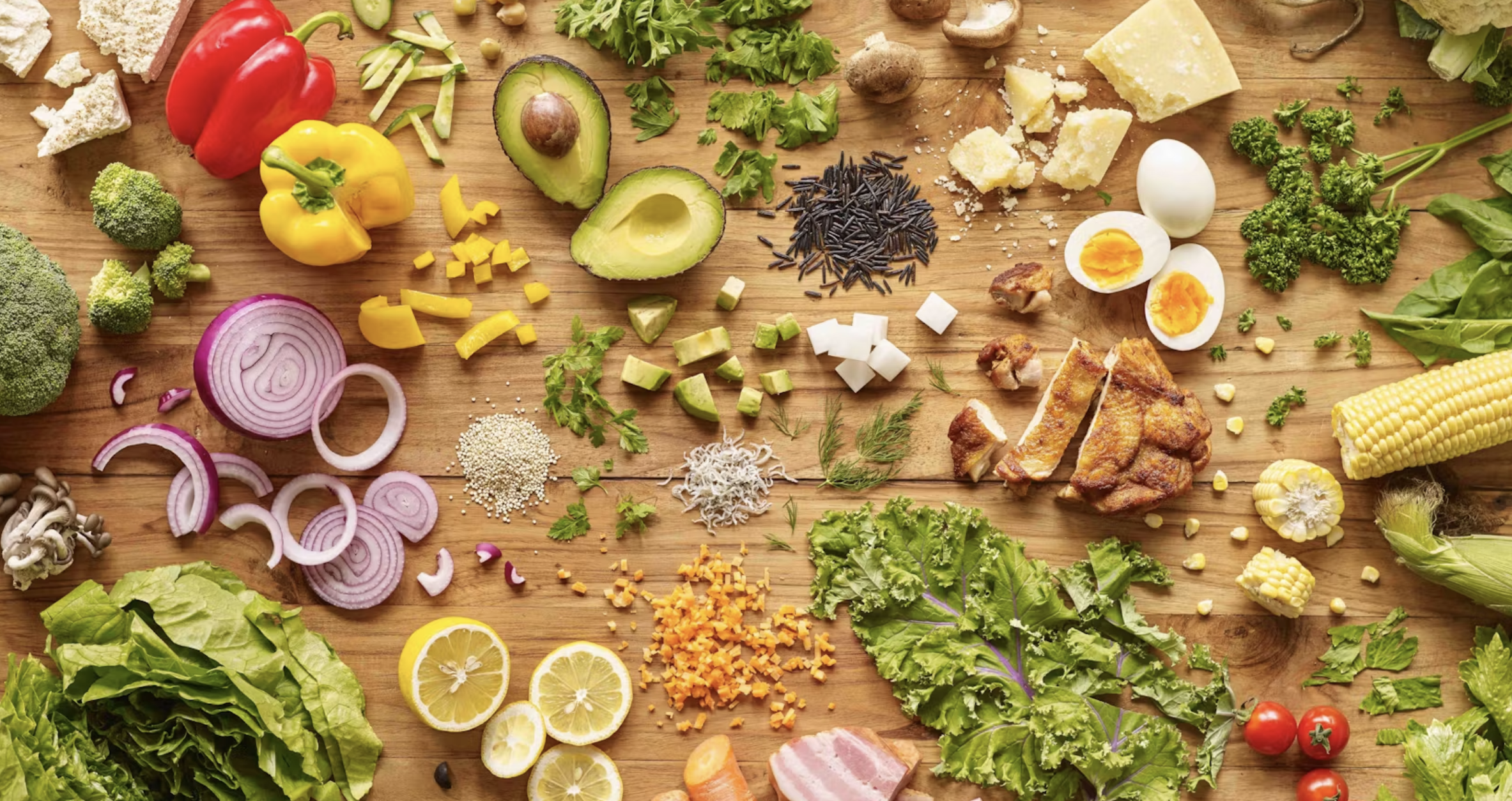
Group 1 foods: Fresh fruits, vegetables, grains, and proteins in their natural state
Group 2: Processed Culinary Ingredients (Oils, Sugars, Fats)
Processed culinary ingredients are substances extracted or derived from Group 1 foods or directly from nature. These ingredients are not meant to be consumed alone but rather used in combination with unprocessed foods during cooking and meal preparation.
Examples include: Vegetable oils, animal fats, sugar, salt, honey and maple syrup, vinegar, and starches.
Role in healthy eating: When used in appropriate amounts, these ingredients enhance the flavor, texture, and palatability of whole foods. The key is moderation—these ingredients should complement, not dominate, your meals.
Group 3: Processed Foods (Canned Goods, Breads, Cheeses)
Processed foods are created by adding processed culinary ingredients (Group 2) to unprocessed or minimally processed foods (Group 1). These foods are typically recognizable as modified versions of their original ingredients and usually contain two to three ingredients.
Examples include: Canned vegetables in salt water, canned fish in oil, traditional cheeses, freshly baked bread, fruits canned in syrup, and smoked or cured meats without industrial additives.
Group 4: Ultra-Processed Foods (UPFs) & Why They're a Concern
Ultra-processed foods represent the most industrially modified end of the processing spectrum. These are industrial formulations created primarily from substances extracted from foods (proteins, sugars, fats) plus additives, with little or no whole food remaining.
The Key Difference: While processed foods are modified whole foods,ultra-processed foods are industrial formulas made from substances extracted from foods. If the ingredient list looks like a chemistry set, it's likely a UPF.
Examples include: Soft drinks, packaged snacks, instant noodles, processed meats with multiple additives, ice cream with artificial ingredients, breakfast cereals with multiple additives, and fast food items.
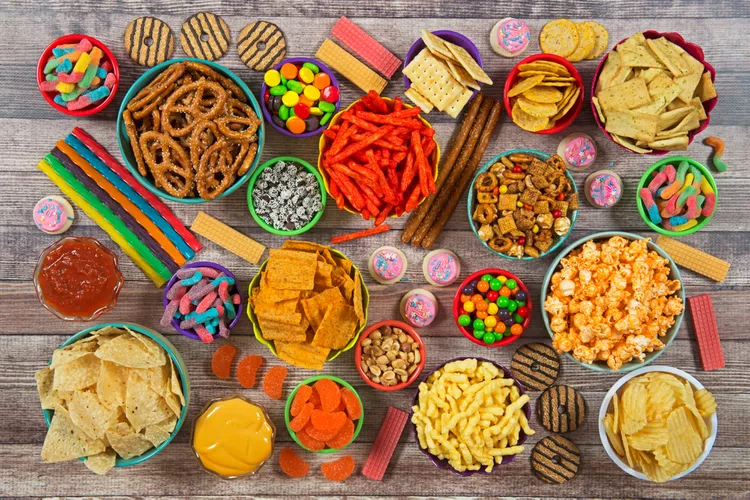
Group 4 foods: Ultra-processed products with industrial ingredients and additives
Real-World Examples
The NOVA classification doesn't rely on nutritional content alone—it focuses on the nature, extent, and purpose of processing. Here are clear examples of how everyday foods fit into each category:
Group 1
- • Fresh apple
- • Brown rice
- • Chicken breast
- • Plain milk
- • Eggs
Group 2
- • Olive oil
- • Sea salt
- • Raw honey
- • Butter
- • White flour
Group 3
- • Canned tomatoes
- • Cheddar cheese
- • Fresh bread
- • Canned beans
- • Smoked fish
Group 4
- • Soft drinks
- • Breakfast cereals
- • Chicken nuggets
- • Energy bars
- • Instant noodles
Common Food Processing Methods
Understanding the various methods used to process food helps you make informed decisions about what you're eating. Each method has different effects on nutritional content, safety, and shelf life.
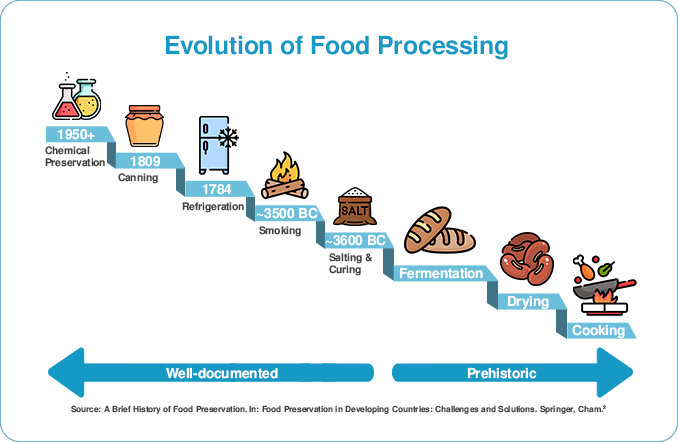
Common food processing methods: From traditional preservation to modern techniques
Freezing and Refrigeration
Freezing and refrigeration slow down bacterial growth and enzyme activity that cause food spoilage. This method has minimal nutrient loss and often preserves more vitamins than fresh produce that travels long distances.
Benefits:
- • Minimal nutrient loss
- • Extends food availability year-round
- • Often more nutritious than "fresh" foods that traveled far
Canning and Bottling
High heat treatment kills harmful bacteria while sealed containers prevent recontamination. While some heat-sensitive vitamins are reduced, fiber, minerals, and some antioxidants remain largely intact.
✅ Preserved:
- • Fiber and minerals
- • Some antioxidants
- • Food safety
⚠️ Reduced:
- • Vitamin C
- • Some B vitamins
- • Heat-sensitive nutrients
Drying and Dehydration
Removing moisture prevents bacterial growth and extends shelf life. This concentrates nutrients per gram but also concentrates natural sugars, making portion control important.
💡 Pro Tip: Dried foods are calorie-dense. A small handful of dried fruit can contain the same calories as a whole piece of fresh fruit!
Fermentation
Beneficial bacteria, yeasts, or molds break down sugars and starches, often enhancing nutritional value. Traditional fermentation is generally beneficial for health, especially gut health.
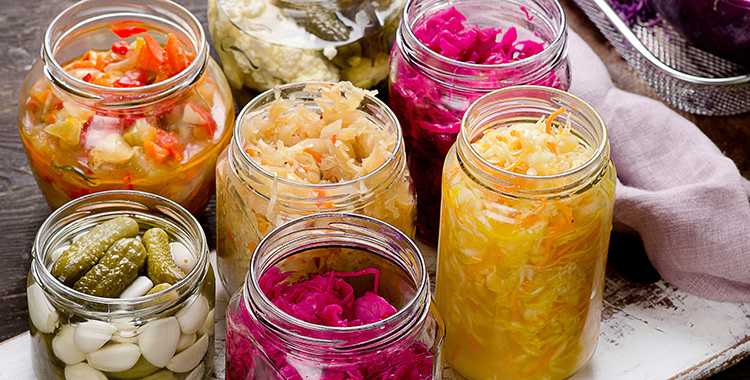
Traditional fermented foods: Yogurt, kimchi, sauerkraut, and other probiotic-rich options
Health Benefits:
- • Creates beneficial probiotics
- • May increase nutrient bioavailability
- • Supports digestive and immune health
Additives and Preservatives
Chemical compounds added to extend shelf life, enhance flavor, or improve texture. The number and type of additives are key indicators of processing level—simple preservatives differ significantly from complex synthetic compounds. For a comprehensive understanding of these substances, read our detailed guide to food additives and preservatives.
✅ Simple/Natural:
- • Salt, sugar, vinegar
- • Citric acid (Vitamin C)
- • Tocopherols (Vitamin E)
⚠️ Complex/Synthetic:
- • BHA, BHT, TBHQ
- • Multiple emulsifiers
- • Artificial colors/flavors
Benefits of Food Processing
While ultra-processed foods rightfully receive criticism, it's important to recognize that food processing itself provides significant benefits to society. Understanding these advantages helps you make informed decisions.
Convenience and Shelf Life
Modern food processing saves time and reduces food waste through extended shelf life. This is particularly valuable for busy families, working professionals, and anyone with time constraints.
Smart Convenience Choices:
- • Pre-cut vegetables (saves prep time)
- • Frozen fruits and vegetables
- • Canned beans (no soaking required)
- • Whole grain pasta
Global Benefits:
- • Reduced food waste
- • Food security during emergencies
- • Lower food costs
- • Global food distribution
Food Safety Improvements
Processing techniques eliminate harmful bacteria, viruses, and parasites that can cause serious illness or death. This is one of the most significant public health achievements in modern history.
Major Safety Achievements:
- • Pasteurization: Eliminated tuberculosis, brucellosis from milk
- • Proper canning: Prevents botulism and spoilage
- • Controlled fermentation: Outcompetes harmful microorganisms
- • Heat treatment: Destroys parasites and pathogens
Nutrient Fortification
Food processing enables the addition of essential nutrients to commonly consumed foods, helping prevent widespread nutritional deficiencies that were once major public health problems.
Success Stories:
- • Iodized salt: Eliminated goiter
- • Fortified cereals: Reduced neural tube defects
- • Vitamin D milk: Nearly eliminated rickets
- • Iron fortification: Reduced anemia in children
Enhanced Bioavailability:
- • Tomato processing increases lycopene
- • Fermentation boosts vitamin availability
- • Cooking breaks down antinutrients
- • Fortification targets specific populations
Health Risks of Ultra-Processed Foods
The growing body of research on ultra-processed foods reveals concerning health implications that go far beyond simple calorie counts. Understanding these risks empowers you to make informed decisions. For a deep dive into the science behind these health impacts, explore our comprehensive analysis ofultra-processed foods and your health.
Important Note: These risks are associated with regular, high consumption of ultra-processed foods as dietary staples, not occasional consumption as part of an otherwise healthy diet.
Links to Obesity and Chronic Disease
Multiple large-scale studies establish strong associations between ultra-processed food consumption and weight gain, cardiovascular disease, type 2 diabetes, and certain cancers. UPFs are engineered to be hyperpalatable, disrupting natural satiety signals and promoting overconsumption.
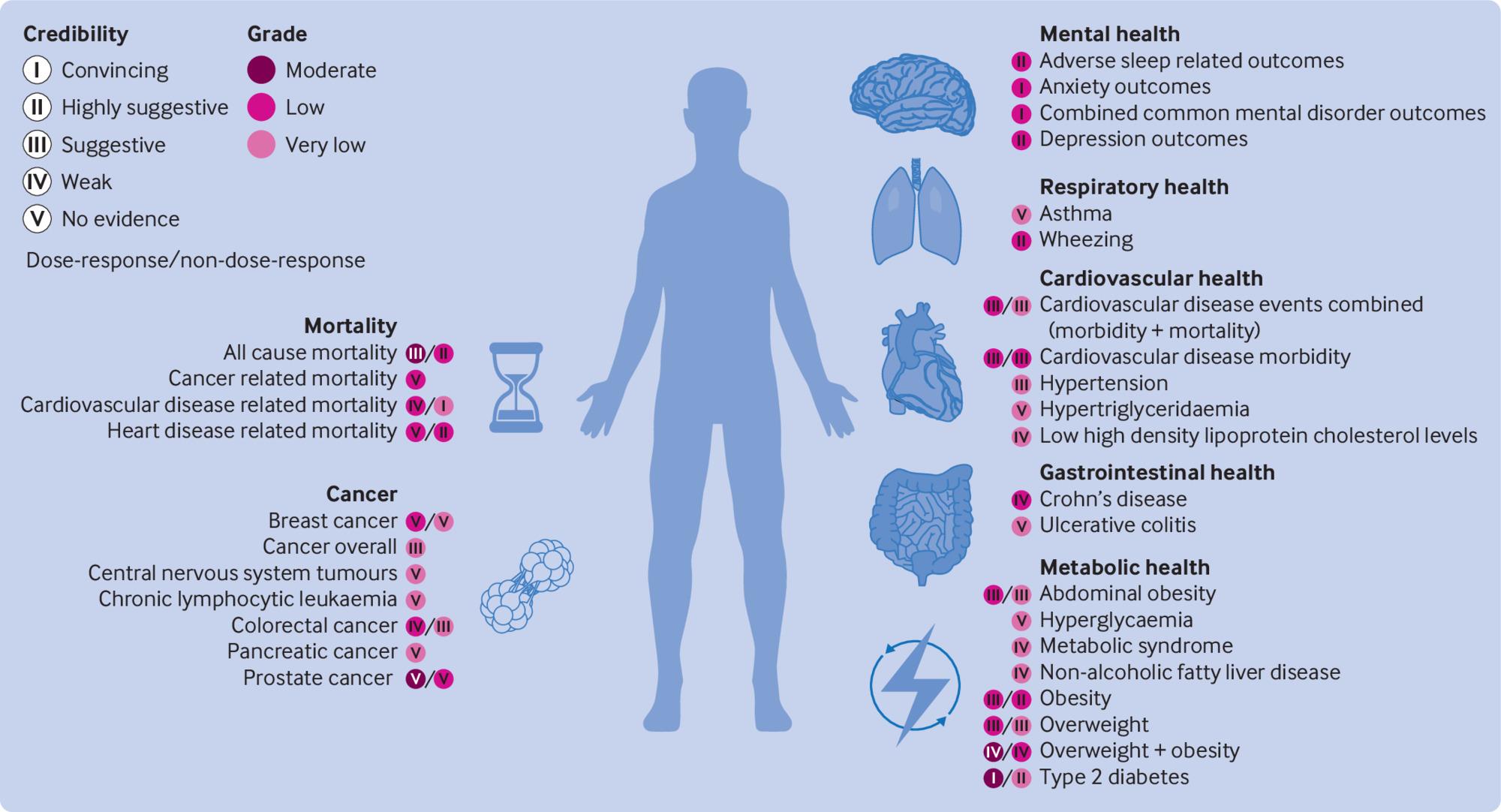
Research findings: Health conditions linked to high ultra-processed food consumption
Why UPFs Promote Weight Gain:
- • Engineered hyperpalatability triggers brain reward pathways
- • Disrupted satiety signals delay fullness
- • High calorie density in small volumes
- • Fast consumption before satiety registers
Associated Conditions:
- • Cardiovascular disease
- • Type 2 diabetes
- • Certain cancers (colorectal, breast)
- • Metabolic syndrome
Impact on Gut Health
Ultra-processed foods can significantly disrupt the gut microbiome—the trillions of bacteria living in your digestive system that play crucial roles in immunity, mood, and overall health.
How UPFs Harm Gut Bacteria:
- • Emulsifiers: Can damage intestinal barrier
- • Artificial sweeteners: May reduce beneficial bacteria
- • Preservatives: Designed to kill bacteria (don't discriminate)
- • Lack of fiber: Starves beneficial microbes
Consequences:
- • Increased intestinal permeability
- • Reduced immune function
- • Chronic inflammation
- • Mood and cognitive effects
Recovery Possible:
- • Increase dietary fiber
- • Add fermented foods
- • Focus on whole foods
- • Reduce UPF consumption
Hidden Sugars, Salts, and Fats
UPFs masterfully hide excessive amounts of sugar, salt, and unhealthy fats behind appealing flavors and marketing. Understanding these hidden ingredients is crucial for making informed food choices. Discover what's really in your food with our detailed exploration ofhidden ingredients in processed foods.
The Sugar Disguise:
Sugar appears under 60+ different names in ingredient lists:
The Salt Trap:
UPFs are the primary source of excess sodium in most diets. A single processed meal can contain 1,000+ mg sodium (nearly half the daily limit).
Fat Content Manipulation:
UPFs often contain trans fats, excessive omega-6 oils, and harmful fat combinations that create particularly damaging metabolic effects.

Label detective work: Spotting hidden processed ingredients in everyday products
How to Read Ingredient Labels Like a Pro
Mastering ingredient label reading is your most powerful tool for identifying ultra-processed foods and making healthier choices. This skill helps you see past marketing claims and understand what you're really eating. Master this essential skill with our completeguide to reading food labels like a pro.
Red-Flag Ingredients to Watch For
High-priority red flags include trans fats (hydrogenated oils), high fructose corn syrup, artificial colors, chemical preservatives (BHA, BHT, TBHQ), and multiple texture modifiers in one product.
Key Red Flags to Avoid:
- • Trans fats: Partially hydrogenated oils, shortening
- • Artificial preservatives: BHA, BHT, TBHQ, sodium benzoate in high amounts
- • Artificial colors: Red 40, Yellow 5, Blue 1, etc.
- • Multiple emulsifiers: When you see 3+ stabilizers/emulsifiers
Decoding Additives and "Natural Flavors"
"Natural flavors" can contain dozens of chemical components and may include solvents and preservatives not listed separately. Understanding additive categories—emulsifiers, stabilizers, preservatives—helps you make informed decisions about which ones you're comfortable consuming.
Common Additive Categories:
- • Emulsifiers: Help oil and water mix
- • Stabilizers: Maintain texture and consistency
- • Preservatives: Extend shelf life
- • Flavor enhancers: Intensify taste
"Natural" Doesn't Mean Simple:
- • Natural flavors can be highly processed
- • May contain carrier solvents
- • Often more chemically complex than artificial
- • Focus on ingredient count, not "natural" claims
Spotting Hidden Sugars
Sugar appears under dozens of names: high fructose corn syrup, dextrose, maltose, fruit juice concentrates, and many others. Use the 4-gram rule (every 4 grams equals 1 teaspoon) to visualize sugar content, and watch for multiple sugar sources in one product.
Pro Tips for Sugar Detection:
- • 4-gram rule: Every 4g sugar = 1 teaspoon
- • Multiple sources: Watch for 2+ different sugars in one product
- • Order matters: Ingredients listed by weight (heaviest first)
- • Sneaky names: Anything ending in "-ose" is usually sugar
Practical Tips to Reduce Ultra-Processed Food Intake
Transitioning away from ultra-processed foods doesn't require perfection—small, sustainable changes can make a big difference in your health over time. Focus on progress, not perfection. Get practical strategies for making this transition with our comprehensive guide onwhole foods vs processed foods.
Easy Swaps and Alternatives
Simple substitutions maintain convenience while improving nutrition: plain oatmeal with fresh fruit instead of sugary cereals, nuts and seeds instead of chips, sparkling water with fruit instead of soda, and homemade trail mix instead of granola bars.
Quick Breakfast Swaps:
- • Plain oats + fruit → Sugary cereal
- • Greek yogurt + berries → Flavored yogurt
- • Whole grain toast + avocado → Pop-Tarts
- • Homemade smoothie → Packaged smoothie
Smart Snack Swaps:
- • Apple + almond butter → Granola bars
- • Air-popped popcorn → Chips
- • Mixed nuts → Crackers
- • Hummus + vegetables → Processed dips
Meal Prep Strategies
Strategic meal preparation makes healthy eating more convenient than processed options. Focus on batch cooking base ingredients (grains, proteins, vegetables), using one-pan meals, slow cooker options, and smart storage solutions to create systems that support whole food choices.
Batch Prep Essentials:
- • Sunday prep: Cook grains, roast vegetables, prepare proteins
- • Freezer meals: Soups, stews, and casseroles for busy weeks
- • Snack prep: Wash/cut fruits and vegetables when you get home
- • One-pan meals: Sheet pan dinners with whole ingredients
Healthy Snacking Ideas
Having satisfying alternatives readily available prevents processed food choices: hard-boiled eggs, Greek yogurt combinations, apple with nut butter, vegetables with hummus, and air-popped popcorn. Preparation and strategic placement are key to success.
Protein-Rich Snacks:
- • Hard-boiled eggs
- • Greek yogurt with nuts
- • Cheese with apple slices
- • Tuna with crackers
Fiber-Focused Options:
- • Raw vegetables with hummus
- • Fresh fruit with skin
- • Air-popped popcorn
- • Whole grain crackers
Energy Combinations:
- • Apple + almond butter
- • Banana + peanut butter
- • Trail mix (homemade)
- • Berries + yogurt
Food Processing Myths vs. Facts
Separating fact from fiction helps you make informed decisions without falling for marketing claims or common misconceptions about food processing.
"All Processing Is Bad"
Myth:
Any processed food is unhealthy.
Fact:
Processing exists on a spectrum. Many techniques like pasteurization, freezing, and fermentation improve food safety and nutrition. The problem is ultra-processing, not processing itself.
"Organic Foods Are Never Processed"
Myth:
Organic automatically means minimally processed.
Fact:
Organic certification relates to how ingredients are grown, not processing level. Organic cookies can be just as ultra-processed as conventional versions.
Clarifying Common Misconceptions
Other myths include "natural means healthy," "chemical-free foods exist," "preservatives are always bad," "fresh is always better than frozen," and "expensive means healthier." Focus on ingredient lists and processing levels rather than marketing claims.
Reality Check:
- • "Natural" doesn't mean healthy: Poison ivy is natural, but that doesn't make it safe
- • "Chemical-free" is impossible: Everything is made of chemicals, including water (H2O)
- • Preservatives can be beneficial: They prevent harmful bacteria and reduce food waste
- • Frozen can beat fresh: Frozen at peak ripeness often has more nutrients than "fresh" shipped produce
- • Price ≠ health: Marketing premiums don't correlate with nutritional value
Conclusion: Making Informed Choices
Understanding food processing empowers you to make choices that support your health without eliminating convenience or enjoyment. The key is balance and awareness, not perfection.
Key Takeaways
Processing exists on a spectrum—build your diet around Groups 1 and 2, enjoy Group 3 in moderation, and minimize Group 4 ultra-processed foods. Focus on patterns, not perfection. Ingredient lists tell the story, and small changes create big impact over time.
Remember These Guidelines:
- • Groups 1 & 2: Form the foundation of your diet
- • Group 3: Enjoy in moderation as part of balanced meals
- • Group 4: Limit to occasional treats, not dietary staples
- • Focus on progress: Small, consistent changes compound over time
Armed with this knowledge about food processing levels, you can make informed decisions that support your health goals without completely eliminating convenience. The key is understanding the spectrum and making choices that align with your individual needs and circumstances.
FAQs on Food Processing
Common questions about food processing, answered with practical guidance to help you navigate food choices confidently.
Is frozen food considered processed?
Yes, frozen food is technically processed, but it falls into minimal processing (Group 1). Freezing preserves nutritional value and often maintains better nutrition than "fresh" foods that have traveled long distances. Look for single ingredients without added sauces or seasonings.
Learn more about the different processing categories in our detailed section onTypes of Food Processing.
Are processed foods always unhealthy?
No, the health impact depends on the type and degree of processing. Many processed foods can be part of a healthy diet: frozen vegetables, canned fish in water, plain yogurt, and traditional cheeses all provide convenience without significantly compromising nutrition.
For more details on making healthy choices, see our comprehensive section onBenefits of Food Processing.
What are examples of ultra-processed foods?
Ultra-processed foods include soft drinks, packaged snacks, instant noodles, processed meats with multiple additives, breakfast cereals with artificial ingredients, and fast food items. They're designed for convenience and palatability rather than nutritional value, with long ingredient lists containing industrial additives.
Common UPF Categories:
- • Soft drinks and energy drinks
- • Packaged snacks (chips, crackers, cookies)
- • Instant and packaged meals
- • Processed meats with multiple additives
- • Breakfast cereals with artificial ingredients
- • Fast food and chain restaurant items
Learn more about recognizing these foods in our detailed guide onHealth Risks of Ultra-Processed Foods.
How do I know if food is highly processed?
Use the ingredient count method (8+ ingredients likely highly processed), the kitchen test (could you make this at home?), and look for red flag ingredients like high fructose corn syrup, artificial colors, and multiple emulsifiers. The more unrecognizable ingredients, the more processed the food.
Quick Assessment Tools:
- • Ingredient count: 8+ ingredients = likely highly processed
- • Kitchen test: Could you make this at home with basic equipment?
- • Recognition test: Do you recognize most ingredients?
- • Shelf life: Extremely long shelf life without refrigeration = red flag
For comprehensive guidance on making better food choices, see our complete section onHow to Read Ingredient Labels Like a Pro.
Scientific References
This guide is based on peer-reviewed research and scientific evidence from leading health organizations and academic journals. Below are key studies and resources that support the information presented.
Key Research Papers & Reviews:
1. Monteiro, C. A., Cannon, G., Levy, R. B., et al. (2019).Ultra-processed foods, diet quality, and health using the NOVA classification system. Food and Agriculture Organization of the United Nations.
Note: The foundational guide to the NOVA system from its creators.
2. Hall, K. D., Ayuketah, A., Brychta, R., et al. (2019).Ultra-processed diets cause excess calorie intake and weight gain: an inpatient randomized controlled trial of ad libitum food intake. Cell Metabolism, 30(1), 67-77.e3.
Note: A landmark clinical trial directly showing UPFs lead to overeating and weight gain.
3. Lane, M. M., et al. (2024).Ultra-processed food exposure and adverse health outcomes: umbrella review of 45 meta-analyses of observational studies. BMJ, 384, e077310.
Note: A recent, large-scale review confirming strong evidence linking UPFs to 32 adverse health outcomes.
4. Srour, B., Fezeu, L. K., Kesse-Guyot, E., et al. (20in9).Ultra-processed food intake and risk of cardiovascular disease: prospective cohort study (NutriNet-Santé). BMJ, 365, l1451.
Note: Key study linking UPFs to heart disease risk.
5. Fagherazzi, G., et al. (2019).Consumption of ultra-processed foods and risk of type 2 diabetes: results from three large prospective French cohorts. Diabetes Care, 42(12), 2313-2320.
Note: Directly supports the link between UPF consumption and Type 2 Diabetes.
6. Fiolet, T., Srour, B., Sellem, L., et al. (2018).Consumption of ultra-processed foods and cancer risk: results from NutriNet-Santé prospective cohort. BMJ, 360, k322.
Note: The primary study linking UPFs to increased cancer risk.
7. Rico-Campà, A., et al. (2019).Association between consumption of ultra-processed foods and all cause mortality: SUN prospective cohort study. BMJ, 365, l1949.
Note: A key study from a Spanish cohort confirming the link between UPFs and risk of death.
8. Chassaing, B., Koren, O., Goodrich, J. K., et al. (2015).Dietary emulsifiers impact the mouse gut microbiota promoting colitis and metabolic syndrome. Nature, 519(7541), 92-96.
Note: Foundational research on how UPF additives can harm the gut microbiome.
9. Adjibade, M., et al. (2019).Prospective association between ultra-processed food consumption and risk of depressive symptoms in the French NutriNet-Santé cohort. BMC Medicine, 17(1), 78.
Note: Provides evidence for the link between UPFs and mental health outcomes.
10. Chen, X., et al. (2020).Ultra-processed food consumption and nutritional intakes and status of US adults: a cross-sectional analysis of the NHANES 2007-2012. Public Health Nutrition, 23(10), 1743-1754.
Note: Shows how UPFs displace essential nutrients from the diet.
Regulatory & Governmental Resources:
• U.S. Food and Drug Administration. Code of Federal Regulations, Title 21, Section 101.22: Spices, flavorings, colorings and chemical preservatives. (Provides the legal definition of "natural flavor").
• World Health Organization. (2023). Guideline: Sugars intake for adults and children.
• U.S. Department of Agriculture. (2020). Dietary Guidelines for Americans 2020-2025.
Note: This information is for educational purposes and should not replace professional medical advice. Always consult with healthcare providers for personalized dietary recommendations.
Explore Related Topics
What is the NOVA Classification System?
Learn about the internationally recognized system for categorizing foods by processing level.
Ultra-Processed Foods and Your Health
Discover the science behind how ultra-processed foods impact your wellbeing.
Reading Food Labels Like a Pro
Master the art of decoding ingredient lists and nutrition labels.
Hidden Ingredients in Processed Foods
Uncover common additives and preservatives lurking in your food.
Whole Foods vs Processed: Making the Switch
Practical tips for transitioning to a less processed diet.
Understanding Food Additives and Preservatives
A comprehensive guide to common food additives and their purposes.